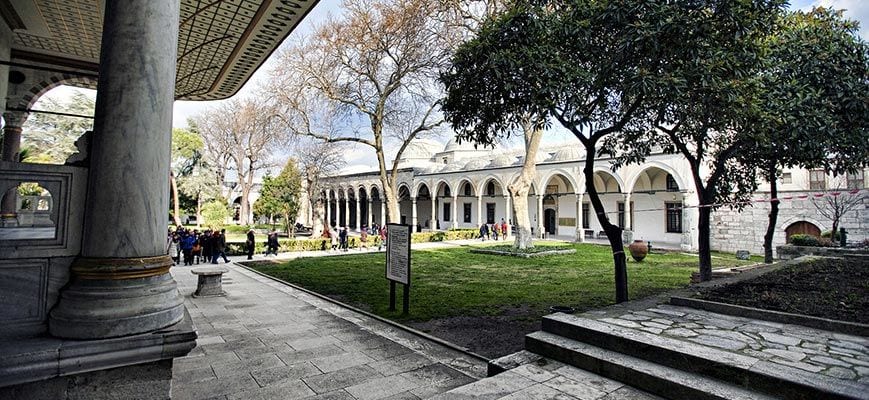No products in the cart.
Information
The Topkapı Palace Information
The Topkapi Palace (in Turkish Topkapi Sarayi) was the main residence of the Ottoman sultans for approximately 400 years (1465-1856) and is a living reflection of the life and architecture of that historical period.
After the Ottoman conquest of Constantinople, by Sultan Mehmet II, he established his temporary residence in the so-called Old Palace, current headquarters of the University of Istanbul, until he chose the old Byzantine acropolis to found his new and glorious residence. The construction began in 1459, on the Sarayburnu, a promontory overlooking the Golden Horn and the Sea of Marmara and one of the highest points of the city near the sea.
According to the Sultan’s own design, at the highest point of the promontory his private rooms were located, surrounded by several buildings and pavilions that extend to the banks of the Bosphorus, protected in turn by high walls, some of which date from the Acropolis Byzantine But while this initial design was respected in a certain way, some structures were added and transformed according to the different periods and sultans in power, which put an end to an asymmetric construction and an erratic growth of the building.
Most of these changes occurred during the reign of Sultan Suleyman, between 1520 and 1560, years of sheer splendor and expansion of the Ottoman Empire, so that his top leader wanted to reflect such glory in his residence, expanding it and building new buildings. In the year 1574 a fire destroyed the kitchen area, and Sultan Selim II commissioned the great architect Sinan to reconstruct the affected parts which ended in another extension of that area as well as the Harem, the bathrooms, the private chamber and some pavilions. By the end of the 16th century, the palace had its current appearance.
Topkapi constitutes an extensive complex and not the traditional monolithic structure of the palaces, with a great variety of low buildings built around patios that are interconnected by galleries and passages. The life of the palace passed around these courtyards, with gardens and fountains that invite to rest and relaxation. The total size of the complex varies from around 592 thousand 600 square meters to 700 thousand square meters, depending on which parts are taken into account.
The palace was like a city inside another city, so rarely did its inhabitants need to venture outside its walls. In its multiple buildings the political functioning of the empire took place. It had its own water supply, through underground cisterns, and large kitchens were provided with food daily. It contained residences, gardens, libraries, schools and mosques.
In 1856 Sultan Abdul Mecid decided to move his court to the newly built Dolmabahçe Palace, the first European-style palace in the city, but despite this, some functions such as the imperial treasury and the library, among others, remained in Topkapi.
After the fall of the Ottoman Empire, the Topkapi Palace was transformed by government decree into a museum of the imperial era, in 1924, administered by the Ministry of Culture and Tourism. Although the palace has hundreds of rooms and chambers, only the most important ones are accessible to the public, which in turn can appreciate large collections of porcelain, costumes, weapons, shields, armor, Ottoman miniatures, Islamic manuscripts, calligraphies and mural paintings, as well as as a display of Ottoman treasures and jewels. In addition, Topkapi has important sacred relics for the Muslim world, such as the mantle and sword of Muhammad.
[tg_program title = “” place = “Of interest for the viewers”] The main appreciable sections in the visit to Topkapi are The Imperial Gate, the Royal Courtyards and their rooms and the Harem. The installation does not have a guide service, although professional guides can be hired at the entrance or audio guides can be purchased, available in several languages.The palace has two schedules during the year, the summer (from April 15 to October 1) from 9:00 to 19:00 and the winter (from October 1 to April 15) from 9:00 to 17 : 00 It is open to the public every day, with the exception of Tuesday. Tickets for the Palace cost 25 TL. Entering the Harem implies an extra payment of 15 TL.
The Santa Irene Byzantine church is only open especially for groups of more than thirty people and with additional entrances.
It is suggested to enter with suitable clothes, especially the halls of religious relics.


